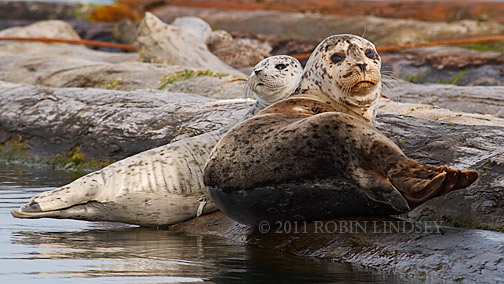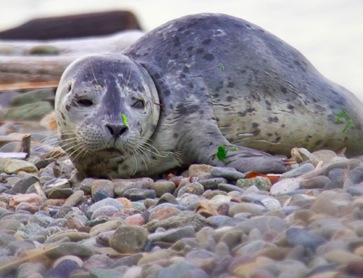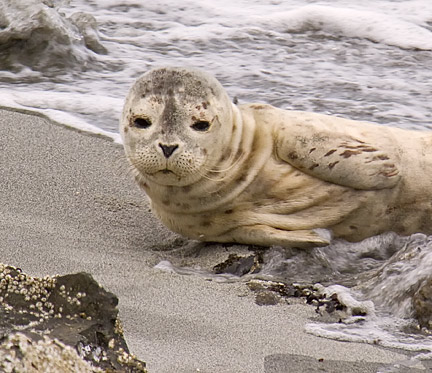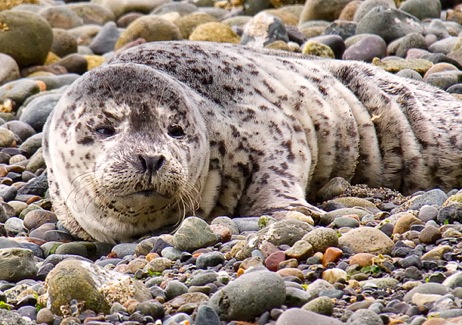Aug 2011
Street banners celebrate pupping season
Aug/29/11 09:31 PM

Fauntleroy ferry dock pup too weak to survive
Aug/27/11 05:39 AM
Seal Sitters and the NOAA Hotline received numerous calls late yesterday morning from concerned folks waiting to board the ferry at the Fauntleroy dock. Our responder found an extremely thin pup at the tide line and established a substantial boundary with yellow tape so that he would not be scared back into the water. We are not sure how long the pup had been at this location, but it was obvious that he was in some serious trouble. Unfortunately, it is a sad fact that every pup in need cannot be rescued from the beach and taken for treatment due to limited treatment resources - PAWS can only accommodate ten pups at a time and the rehab is quite lengthy. In dire emergencies, a pup can be flown to Wolf Hollow Wildlife Center in the San Juans courtesy of Kenmore Air. That trip, however, is extremely stressful for any wild animal who already is in a tenuous battle to live. Whenever possible, stranding network volunteers monitor an animal for 24 hours in hopes they will return to the Sound to forage for food in an effort to survive. After observing this horribly thin pup, nicknamed Qakak by neighbors, Seal Sitters intervened mid-afternoon and rescued him from suffering on this beach frequented by people with off-leash dogs - always a danger to seal pups. The pup died en route to PAWS and will be necropsied by WDFW Marine Mammal Investigations’ biologist to determine cause of death.
Thanks to the kayakers who went well out of their way to launch further up the beach. They realized that a small inconvenience to humans can often be the difference between life and death to a resting baby animal. Many kudos to those caring adults and kids.
On a brighter note, Sandy, the small pup rescued from another West Seattle beach, is doing well at PAWS and could be our first success story of this season. Early in the past two seasons, we have had terribly small pups who have struggled with no mom around. It is a tough statistic that only 50% of pups make it to their first year and nature can be pretty harsh at times - all the more reason that they need to rest. Take heart that soon, we will have some fat little pups who have been successfully weaned in the rookeries visiting our beaches!
Thanks to the kayakers who went well out of their way to launch further up the beach. They realized that a small inconvenience to humans can often be the difference between life and death to a resting baby animal. Many kudos to those caring adults and kids.
On a brighter note, Sandy, the small pup rescued from another West Seattle beach, is doing well at PAWS and could be our first success story of this season. Early in the past two seasons, we have had terribly small pups who have struggled with no mom around. It is a tough statistic that only 50% of pups make it to their first year and nature can be pretty harsh at times - all the more reason that they need to rest. Take heart that soon, we will have some fat little pups who have been successfully weaned in the rookeries visiting our beaches!
Pups fattening up in area rookeries
Aug/23/11 07:22 AM

There have been a number of pups on the beaches of Whidbey Island, Everett, Tulalip and West Seattle - all very young and some with umbilicus still attached. Shown in the photo above, a chubby and active newborn pup (note umbilicus cord) rests with a very attentive mom on a logboom in the north end. Seals often use log booms and docks to rest and nurse their young. Seal moms and their pups need this time to rest undisturbed, so observe quietly from a distance. In the rookeries, pups are in various stages of being weaned (pups nurse for 4-6 wks), dependent on the date of their birth. As pups are weaned, they will venture off on their own, following schools of small bait fish - and that is when we will begin to see an influx of pups visit our shores; September and October are the busiest months for Seal Sitters. Sometimes, too, at the end of pupping season as the food source dwindles near the rookeries, moms with pups will travel away from the safety of the rookery in search of food. As always, any time you see a pup alone on the beach, stay back (NOAA recommends 100 yds when possible), keep people and dogs away and call Seal Sitters’ hotline @ 206-905-SEAL (7325).
Seal pup Sandy doing well in rehab
Aug/19/11 07:20 PM

Sandy is shown here in the light of early evening on the pebbled beach north of the Water Taxi landing. A seal’s fur looks very different when wet or dry (see dry photo in story below), often making identification difficult. For this reason we try to get detailed photos of spots and markings which enables us to track an animal if there are health concerns. In Sandy’s case, she had very defined markings on her left foreflipper and around the eyes, so we were easily able to identify her when she hauled out on a different beach.
PUPDATE 8/22/11 PAWS reports that Sandy is still doing well and taking whole fish.
Small pup hauls out on sandy beach
Aug/14/11 11:21 PM

Seal Sitters would like to extend special thanks to Greg and Alki Kayak Tours for being so cooperative in sharing the cove with this very sweet and very tired little pup - and for keeping people at bay until our volunteers could arrive on scene.
PUPDATE 8/15/11 12:30 pm: Sandy, a too thin pup who apparently has no attending mom, was still on the beach at sunrise this morning and was taken to PAWS. Please check back for updates.
PUPDATE 8/15/11 4:30pm: PAWS reports that Sandy is doing well at the facility. She is a female, but weighs a mere 7.1 kg (or 15.6 lbs). That weight is a full two pounds less than our little beauty, Storm, who we rescued from Lincoln Park last year - and who was successfully rehabbed and released by PAWS ten weeks later. A healthy pup being nursed by mom should weigh between 21-23 kg. Keep Sandy in your thoughts as she will undoubtedly face some challenges.
Chicken soup for the Seal Sitters' soul
Aug/13/11 03:57 PM
Sad news from Arroyo Beach
Aug/12/11 08:14 AM
(see update end of story) Seal Sitters is so sad to report that our first pup of the year, Tiny, died on Arroyo Beach yesterday afternoon. Tiny had rested there all day Wednesday, returning to the water briefly, only to haul out again on a timber in the water until after dark. Early in the morning, Tiny was reported gone. Our responder hiked and scoured a huge expanse of beach almost to Brace Point, as well as beaches to the south. However, Tiny was sleeping tucked in among some rocks at the sea wall, unseen. Later that afternoon, he was discovered by a homeowner who called the hotline. Tiny died trying to return to the Sound as our volunteers arrived on scene.
Yesterday morning Seal Sitters assisted in the necropsy by WDFW Marine Mammal Investigations of an adult female seal just north of Lowman Beach. The female was postpartum and WDFW’s biologist estimated that the seal had given birth approximately 10 or so days before. This would very closely match the estimated age of Tiny when he showed up at the north end of Lincoln Park, just a short distance away. While we cannot say with certainty that the female was indeed his mom, it seems quite likely. Our investigator was troubled that the pup was not gaining weight if indeed he was being nursed; however, his pattern of returning to the water, traveling a fair distance to Arroyo Beach south of the park, and the fact that an adult seal had been seen on the platform offshore all contributed to the possibility that he had a mom around. With limited resources for rehabilitation in our area (in addition to the low success rates of rehabbing a newborn pup) it is always best for a pup to remain in the wild with mom if at all possible. Such a small pup needs mom to teach foraging skills to survive in the wild; while rehabbers do an amazing job, those innate survival skills cannot be taught by humans tossing fish in a small pool. A pup always has his best chance of survival with mom’s tutelage on how to forage successfully for food, all the while nursing on her rich milk.
A necropsy will be performed on the pup and we will provide updates to cause of death for both seals as results become available. This is, by far, the hardest part of the work we do. This little seal brought great joy to our volunteers and neighbors who watched over him. Tiny’s short life enlightened many to the struggles that seal pups face and the urgent need to let them rest. We are terribly sad, but heartened to know that we will have many success stories over the next months.
NECROPSY RESULTS 8/15/11: Tiny, a male pup, weighed 10 kg (approx 22 lbs) and had a very thin blubber layer.
Yesterday morning Seal Sitters assisted in the necropsy by WDFW Marine Mammal Investigations of an adult female seal just north of Lowman Beach. The female was postpartum and WDFW’s biologist estimated that the seal had given birth approximately 10 or so days before. This would very closely match the estimated age of Tiny when he showed up at the north end of Lincoln Park, just a short distance away. While we cannot say with certainty that the female was indeed his mom, it seems quite likely. Our investigator was troubled that the pup was not gaining weight if indeed he was being nursed; however, his pattern of returning to the water, traveling a fair distance to Arroyo Beach south of the park, and the fact that an adult seal had been seen on the platform offshore all contributed to the possibility that he had a mom around. With limited resources for rehabilitation in our area (in addition to the low success rates of rehabbing a newborn pup) it is always best for a pup to remain in the wild with mom if at all possible. Such a small pup needs mom to teach foraging skills to survive in the wild; while rehabbers do an amazing job, those innate survival skills cannot be taught by humans tossing fish in a small pool. A pup always has his best chance of survival with mom’s tutelage on how to forage successfully for food, all the while nursing on her rich milk.
A necropsy will be performed on the pup and we will provide updates to cause of death for both seals as results become available. This is, by far, the hardest part of the work we do. This little seal brought great joy to our volunteers and neighbors who watched over him. Tiny’s short life enlightened many to the struggles that seal pups face and the urgent need to let them rest. We are terribly sad, but heartened to know that we will have many success stories over the next months.
NECROPSY RESULTS 8/15/11: Tiny, a male pup, weighed 10 kg (approx 22 lbs) and had a very thin blubber layer.
Tiny finds new, quieter place to rest
Aug/10/11 03:27 PM
Concerned and respectful neighbors spread the word that there was a resting pup and for dog owners to please keep their dogs off the beach.
Tiny visitor comes ashore today - first pup of the season
Aug/09/11 06:43 PM

Please be on the lookout for Tiny. The pebbled coat provides excellent camouflage on the beach, so be alert as you walk along. If you see him, please make sure to keep people and dogs away and call our hotline @ 206-905-SEAL (7325). It is imperative that a nursing pup not be scared back into the water, venturing off to another location where mom can’t find him. The pup does not have the means to survive on his own.
UPDATE 8/10/11 5:38am
It has been verified that the pup has a small stub of umbilicus and is estimated at little more than a week old. Many thanks to WDFW’s Dyanna Lambourn for her on-going expertise and help advising Seal Sitters in matters of health concerns!
Stranding network featured on WA Ferries website
Aug/04/11 08:15 AM
Seal Sitters MMSN and the NW Marine Mammal Stranding Network are featured on the Washington Ferries website “Spotlight” this month. There is a link to the public service announcement which Seal Sitters produced for the region. This is tremendous visibility for the network - the message to give seals space and call the local stranding network will be viewed by thousands of travelers in Puget Sound.
Thanks so much to Marta, Jayne, Laura and Joy of WSDOT for helping us get this vital message out! Check out Spotlight here.
Thanks so much to Marta, Jayne, Laura and Joy of WSDOT for helping us get this vital message out! Check out Spotlight here.
Rehabbed seal pups behave differently than wild pups
Aug/04/11 07:57 AM
Each year, seal pups are taken for rehabilitation to PAWS in Lynnwood and Wolf Hollow on San Juan Island, the two excellent, but limited resources for our region. Pups are removed from the wild due to human interference, endangerment or compromised health. In a Seattle Times article by Lynda Mapes published yesterday, a study being conducted by SeaDoc Society shows that rehabbed seal pups behave quite differently than those who have lived solely in the wild, in particular their foraging patterns - evidence that a pup should always remain with his mom whenever possible to learn the skills to survive. The decision to remove a seal pup from the beach is one that is weighed heavily by stranding experts. Read the article here.
Many thanks to Lynda for keeping seal pups in the forefront of the news and for giving Seal Sitters a nice mention. Lynda has been a great ally of our network over the past few years.
Many thanks to Lynda for keeping seal pups in the forefront of the news and for giving Seal Sitters a nice mention. Lynda has been a great ally of our network over the past few years.







